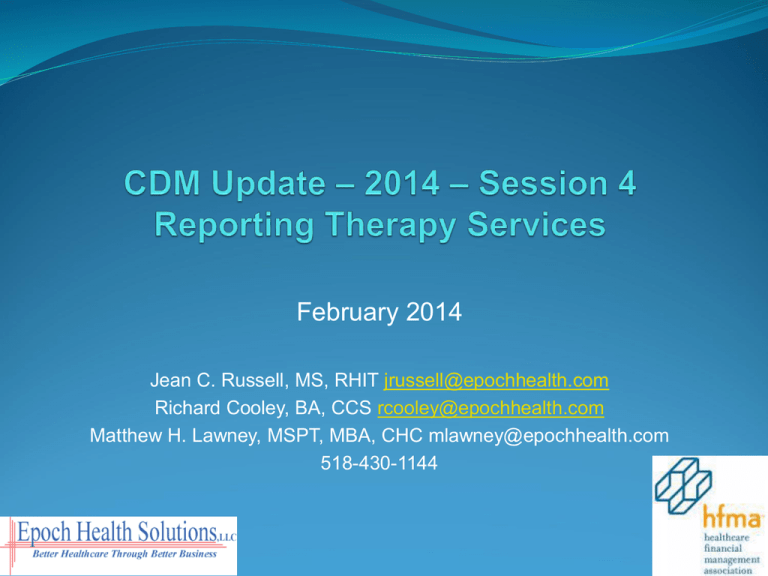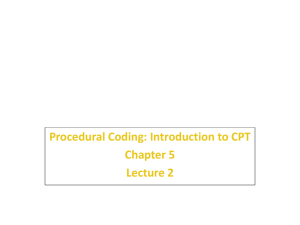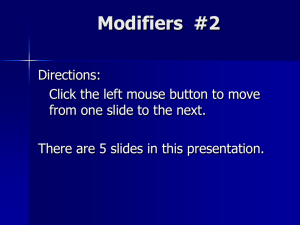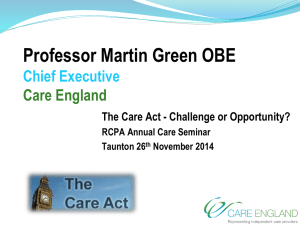
February 2014
Jean C. Russell, MS, RHIT jrussell@epochhealth.com
Richard Cooley, BA, CCS rcooley@epochhealth.com
Matthew H. Lawney, MSPT, MBA, CHC mlawney@epochhealth.com
518-430-1144
2
Agenda
•
•
•
•
Payment Basics
2014 PT / OT / SP Codes
• Deleted Codes
• New Codes
Significant Changes
• Therapy Cap
• Claims-based data collection for
therapy services
Modifiers
3
Payment
Medicare
Majority of codes are paid off the Physician Fee
Schedule
Some APC Services
Majority of codes are “timed codes”
Services must be performed under a “plan of
care”
New to hospitals
Payment Caps
Outcome reporting
4
Payment
Medicaid
Either paid under APGs or off Fee
Schedule depending if facility has a “clinic
rate”
APG reimbursement higher than Fee
schedule reinbursment
5
Payment
Medicaid
Units impact reimbursement for many
therapy procedures
Discounted, not consolidated
E/M will not be packaged when reported
with the therapies – that is, both will be
paid
6
Payment
Medicaid
Each visit should be separately reported
Do not bill recurring therapies on different dates of
service on separate claims
Beginning July 1, 2010, therapies performed in
hospital outpatient departments (even those that are
referred amb) will be reimbursed under APGs
Translation – Bill the therapies with a rate code
(e.g., 1432)
7
Deleted Codes
92506 – Evaluation of speech, ;language, voice,
communication, and/or auditory processing disorder
8
New Codes
92521 - Evaluation of speech fluency (eg, stuttering,
cluttering)
92522 – Evaluation of speech sound production (eg,
articulation, phonological process, apraxia,
dysarthria)
92523 - Evaluation of speech sound production; with
evaluation of language comprehension and
expression (eg, receptive and expressive language)
92524 – Behavioral and qualitative analysis of voice
and resonance
9
Why New Speech Codes?
The four new evaluation codes were developed by ASHA in
collaboration with experts in the field from ASHA's Special Interest
Groups.
AMA's Relative Value Update Committee re-evaluated speechlanguage pathology codes to include "professional work" value (one
of three components of a code's value that reflects the amount of
time, technical skill, physical effort, stress, and judgment required to
provide the service.
Developed specific evaluation procedure codes to replace 92506 to
more accurately and appropriately value the professional work
performed.
10
Can They be Billed
Together?
Neither the CPT Handbook or the National Correct
Coding Initiatives (CCI) edits restrict an SLP's ability to
bill the new codes together.
There are circumstances when it is appropriate for a patient to be
evaluated for multiple disorders on the same day.
The exception is the same-day billing of the combination of 92522
and 92523, which is restricted by both the CPT Handbook and
CCI edits.
In cases when multiple evaluations may be appropriate,
documentation should clearly reflect a complete and distinct
evaluation for each disorder.
Evaluation codes should not be billed for brief assessments that
could be considered screenings.
11
92523 - What if Language
Evaluation is Only Performed?
If a patient is evaluated only for language, SLPs
should bill 92523 with the -52 modifier
-52 is used when the services provided are reduced in
comparison with the full description of the service
There is also an aphasia assessment code (CPT
96105) that may be appropriate for some patients
12
Non-speech Generating
Device Evaluation
Medicare Part B instructs SLPs to use the deleted code
CPT 92506 to bill for a non-speech generating device
evaluation
ASHA recommends billing CPT 92523 until a better
replacement is developed.
13
Therapy Cap
In 2014, the annual per beneficiary therapy
cap amounts are:
$1,920 for physical therapy and speech
language pathology services combined
There is a separate $1,920 amount
allotted for occupational therapy
services.
14
Therapy Cap
In 2014, the therapy caps with an exceptions process
applies to services furnished in the following outpatient
therapy settings:
Physical, Occupational and Speech Therapists in private practice,
physician offices, skilled nursing facilities (Part B), rehabilitation
agencies (or ORFs), and comprehensive outpatient rehabilitation
facilities (CORFs), and outpatient hospital departments.
Application of the therapy cap in critical access hospitals
(CAHs) for 2014
15
Therapy Cap Exception
Exceptions applicable for therapy services in excess
of the cap amount delivered any time during the
2013 calendar year.
The 2 exceptions processes are:
An automatic exception process
A manual medical review exception process
Applies to patients who meet or exceed $3,700 in therapy
expenditures for PT/SLP combined and
A separate $3,700 in occupational therapy expenditures.
16
Automatic Exceptions
May be made when the patient's condition is
justified by documentation that indicates the
beneficiary requires continued skilled therapy to
achieve their prior functional status or maximum
expected functional status within a reasonable
amount of time.
Can be used for any diagnosis for which they can
justify services exceeding the cap.
17
Automatic Exceptions
The automatic exception can be used
for claims that are between $1,900
and $3,700
Claims exceeding $3,700 will be
subject to manual medical review in
order to be paid
18
Submitting a Request for
an Automatic Exception
When the beneficiary qualifies for a therapy cap
exception, the provider should apply the KX modifier
to the therapy procedure code subject to the cap
limits
Codes subject to the therapy cap tracking
requirements are listed in a table in the Medicare
Claims Processing Manual, Chapter 5, Section 20(B)
19
Using the KX Modifier
The KX modifier attests that the services
billed:
Qualified for the cap exception;
Are reasonable and necessary services
that require the skills of a therapist; and
Are justified by appropriate
documentation in the medical record.
It should not be routinely applied
20
Additional Documentation
Providers do not need to submit additional
documentation for automatic exceptions
Documentation justifying the services are
necessary in response to any Additional
Documentation Request (ADR) for claims that
are selected for medical review.
21
Manual Medical Review
Claims for patients who meet or exceed $3,700 in
therapy expenditures will be subject to a manual
medical review.
Criteria for medical review is based on current
medical review standards.
Medicare Administrative Contractors (MAC) have 10
business days to make decisions regarding whether
services will be approved over the $3,700 threshold
22
Manual Medical Review
If a decision is not made by the MAC within 10
business days, the MAC should notify the provider
that they did not review the request and that claims
beyond the $3,700 threshold will be approved.
Advanced approval will allow an additional 20
treatment days beyond the $3,700 amount.
Does not guarantee payment.
May still be reviewed retrospectively
When more than 20 days are required the provider
must submit an additional request for more service.
23
Manual Medical Review
Advanced approval should be requested before
providing the service.
When a provider did not request advanced approval
prior to providing services over $3,700
Payment for the claims will stop
Request for medical records will be sent to the
provider
Provider will be subject to prepayment review for those
claims (approximately 60 day review period)
24
Manual Medical Review
Refer to the MAC website for information on what is
required for advanced approval
Providers may and should submit the request to the
MAC when the patient is close to exceeding the
$3,700 if additional services are medically
necessary.
Submit the KX modifier on the claim form when
therapy services exceed $3,700, the MACs will also
give the provider a tracking number that should be
placed on the claim
25
Identifying Cap Dollars
The cap is an annual cap
It does not reset with a change in diagnosis
Providers may access the accrued amount of
therapy services from the ELGA screen inquiries into
CWF
Providers may access the remaining therapy
services limitation dollar amount through the 270/271
eligibility inquiry and response transaction
Providers who bill to FIs will find the amount a
beneficiary has accrued toward the financial
limitations on the HIQA
26
Not Qualifying for Exception
If the patient does not qualify for an exception to the
cap, they can continue to receive services and pay
for these services out of pocket
The provider must obtain a signed Advanced
Beneficiary Notice (CMS-R-131) (ABN) from the
patient
27
Not Qualifying for Exception
Providers should continue to submit the claim to
Medicare with the modifier for a denial:
GA (Waiver of Liability Statement Issued as Required
by Payer Policy)
GY (Notice of Liability Not Issued, Not Required Under
Payer Policy)
GX (Notice of Liability Issued, Voluntary Under Payer
Policy) codes
Can bill a secondary insurance
28
Functional Reporting
Beginning July 1, 2013, practice settings that
provide outpatient therapy services had to include on
claim forms information regarding the beneficiary’s
function and condition, therapy services furnished,
and outcomes achieved.
Failure to do so results in payment penalties
29
Functional Reporting
Apply to PT, OT and SP services furnished in:
Skilled Nursing Facilities (Part B stay)
Rehabilitation Agencies
Home Health Agencies (for beneficiaries who are not under a Home Health plan of
care, are not homebound, and whose therapy or other services are not paid under
the Home Health prospective payment system)
CORFs (PT, OT, and SLP services)
Hospitals, including beneficiaries in Outpatient and Emergency Departments, and
inpatients paid under Part B
Critical Access Hospitals
Therapists in Private Practice
Physicians: Medical Doctors (MDs), Doctors of Osteopathy (DOs), Doctors of
Podiatric Medicine (DPMs), and Doctors of Optometry (ODs)
NPPs: Nurse Practitioners (NPs), Clinical Nurse Specialists (CNSs), and
Physician Assistants (PAs)
30
Purpose of Functional
Reporting
Medicare uses this information to reform future
payment structure for outpatient therapy services
Moving towards a bundled payment system
Through data collection of beneficiary function CMS
hopes to:
Understand who uses therapy services
Understand how a patient’s functional limitations
change over time as a result of the therapy
31
Functional Reporting
CMS is not currently changing how therapy claims
are paid.
The rules governing therapy documentation and
reimbursement and coverage requirements all
remain the unchanged
32
The G-Codes
CMS will require providers to report G-codes to
collect information on beneficiaries’ function and
condition on claims forms
42 G-codes were established to describe the
patient’s functional limitation that is the primary
reason for the therapy services
33
Review of G Codes
CPT/HCPCS
G0456
G0457
G8978
G8979
G8980
G8981
G8982
G8983
G8984
G8985
G8986
G8987
G8988
G8989
G8990
G8991
G8992
G8993
G8994
G8995
G8996
G8997
Description
Neg pre wound <50 sq cm
Neg pres wound >50 sq cm
Mobility current status
Mobility goal status
Mobility D/C status
Body pos current status
Body pos goal status
Body pos D/C status
Carry current status
Carry goal status
Carry D/C status
Self care current status
Self care goal status
Self care D/C status
Other PT/OT current status
Other PT/OT goal status
Other PT/OT D/C status
Sub PT/OT current status
Sub PT/OT goal status
Sub PT/OT D/C status
Swallow current status
Swallow goal status
CPT/HCPCS
G8998
G8999
G9158
G9159
G9160
G9161
G9162
G9163
G9164
G9165
G9166
G9167
G9168
G9169
G9170
G9171
G9172
G9173
G9174
G9175
G9176
G9186
Description
Swallow D/C status
Motor speech current status
Motor speech D/C status
Lang comp current status
Lang comp goal status
Lang comp D/C status
Lang express current status
Lang express goal status
Lang express D/C status
Atten current status
Atten goal status
Atten D/C status
Memory current status
Memory goal status
Memory D/C status
Voice current status
Voice goal status
Voice D/C status
Speech lang current status
Speech lang goal status
Speech lang D/C status
Motor speech goal status
34
G-Code Examples
Mobility: Walking & Moving Around
G8978 Mobility: walking and moving around functional limitation,
current status, at therapy episode outset and at reporting
intervals.
G8979 Mobility: walking and moving around functional limitation,
projected goal status, at therapy episode outset, at reporting
intervals, and at discharge or to end reporting.
Swallowing
G8996 Swallowing functional limitation, current status, at time of
initial therapy treatment/episode outset and reporting intervals.
G8998 Swallowing functional limitation, discharge status, at
discharge from therapy/end of reporting on limitation
35
G- Codes
Therapists should familiarize
themselves with all 42 of the new Gcodes.
Required for PT, OT and SP services
36
G-Code Modifiers
With each G-code, a modifier must be reported to
demonstrate the severity and complexity of the
functional limitation.
There are seven modifiers which could be selected
(a seven point scale)
The therapist bases the assessment on the score of
an outcome measurement tool as well as their skilled
clinical knowledge
In addition to reporting G-codes and modifiers, the
therapists must continue to report the GO, GP, and
GN modifiers as appropriate
37
G-Code Modifiers
38
Other Relevant Modifiers
HCPCS codes should be accompanied by the following modifiers
in FL 44. The modifiers are:
• GN: Service delivered personally by a speech-language
pathologist or under an outpatient speech-language pathology
plan of care
• GO: Service delivered personally by an outpatient occupational
therapist or under an occupational therapy plan or care
• GP: Service delivered personally by a physical therapist or under
an outpatient physical therapy plan of care
38
39
Always and Sometimes Therapy
Codes
The following codes are “always therapy”
services. These codes always require therapy
modifiers (GP, GO, GN):
92506, 92507, 92508, 92526, 92597, 92605,
92606, 92607, 92608, 92609, 96125, 97001,
97002, 97003, 97004, 97010, 97012, 97016,
97018, 97022, 97024, 97026, 97028, 97032,
97033, 97034, 97035, 97036, 97039, 97110,
97112, 97113, 97116, 97124, 97139, 97140,
97150, 97530, 97533, 97535, 97537, 97542,
97750, 97755, 97760, 97761, 97762, 97799,
G0281, G0283, G0329.
39
40
Continued… “Sometimes Therapy”
No modifier is required if not performed by a
therapist under a therapy plan of care.
However, these codes when performed by a
therapist require the use of a therapy
modifier:
90901, 92610, 92611, 92612, 92614, 92616,
95831, 95832, 95833, 95834, 95851,
95852, 96105, 96110, 96111, 97532, 97597,
97598, 97602, 97605, 97606, 0019T, 0029T
40
41
Initial Evaluation Codes 97001
and 97003
o Include all components necessary to evaluate
the patient; all tests and measurements
performed during the initial evaluation are
inclusive of the code and should not be
separately reported.
o Only one unit of an initial evaluation should be
billed regardless of the time spent with the
patient.
o Treatments performed in addition to the initial
evaluation can be separately reported as long
as Medicare requirements are met.
41
42
Billing Units
Constant attendance" services require direct
one-on-one provider-patient contact and
generally fall within the 97032-97762 HCPCS
ranges.
The CDM Description should indicate these
codes as timed codes
When performed, medically necessary and
documented, the therapist may bill for multiple
units
42
Patient Contact Time
43
Time Interval
Units
Billed
8 – 22 Minutes
1
23 – 37 Minutes
2
38 –52 Minutes
3
53 – 67 Minutes
4
68 – 82 Minutes
5
83 – 97 Minutes
6
98 – 112 Minutes
7*
*The time interval / units billed follow the
same pattern should greater than 7
units be performed
44
Timed Codes (CPT Rules)
The expected average time spent for these codes is
15 minutes
Providers should not bill for services performed for
less than 8 minutes
If more than one CPT code is billed during a
calendar day, then the total number of units that can
be billed is constrained by the total treatment time
44
45
Example
24 minutes of code 97112 and 23 minutes
of code 97110 were furnished
Total treatment time was 47 minutes;
3 units can be billed for this encounter.
The correct coding is:
45
2 units of code 97112
1 unit of code 97110
Assign more units to the service that took the
most time.
46
Specific Limits for HCPCS
46
47
Questions and Discussion
48
Contact Us
Jean Russell
Phone:
Email:
845-642-6462
mlawney@EpochHealth.Com
Richard Cooley
Phone:
Email:
518-430-1144
RCooley@EpochHealth.Com
Jean Russell
Phone:
Email:
518-369-4986
JRussell@EpochHealth.Com
49
http://www.EpochHealth.com/
50
CPT®
Current Procedural Terminology (CPT®)
Copyright 2012 American Medical
Association
All Rights Reserved
Registered trademark of the AMA
51
Disclaimer
Information and opinions included in this
presentation are provided based on our
interpretation of current available regulatory
resources. No representation is made as to the
completeness or accuracy of the information. Please
refer to your payer or specific regulatory guidelines
as necessary.







